Kidderminster and Stourport Electric Tramway
History
The building of an electric tramway between Kidderminster and Stourport was first mooted in 1895, by a group of individuals who would go on to play a key role in the development and operation of electric tramways in the British Isles and abroad. The main protagonists were Emile Garcke, Sir Charles Rivers Wilson and John Raworth, who — to further their aims and to raise the enormous amounts of capital required to realise them — formed the British Electric Traction (Pioneer) Company Limited, on the 7th September 1895.
Following negotiations with Kidderminster Borough Council and Stourport Urban District Council, the promoters applied for powers to build an electric tramway between the two towns, the resulting act — the Kidderminster and Stourport Electric Tramways Act — receiving its Royal Asset on the 7th August 1896. This act also incorporated a company — the Kidderminster and Stourport Electric Tramways Company — to finance, build and operate the tramway. The company was in effect a subsidiary of the BET(P)Co, which on the 26th October 1896, changed its name to the British Electric Traction Company Limited.
Construction of the 3ft 6ins-gauge overhead electric tramway commenced in mid-July 1897, the completed system opening almost a year later on the 25th May 1898, in large measure due to the significant amount of road and bridge widening that was required. The system was 4.6 miles long, and remained as built for its entire lifetime. From a terminus at the junction of Somerleyton Avenue and Comberton Road (to the east of Kidderminster), the line ran via Comberton Hill and Worcester Cross to Oxford Street, where there was a terminal stub (the main Kidderminster terminus) outside the Green Man and Still Hotel. From here, the main line ran roughly southwards along Bridge Street, New Road and Stourport Road to Stourport, where it proceeded via Boundary Street, Lombard Street, High Street and Bridge Street to the southern terminus outside the Bridge Inn, just short of the River Severn.
The initial services were operated with six single-deck tramcars and three single-deck trailers, the use of the latter being fairly common outside the British Isles, though it was soon to be frowned on by the Board of Trade. As a consequence, trailer operation only lasted a few years, the trailers either being motorised, i.e., converted into trams, or sold on (probably the fate of four more that were ordered), with the shortfall in capacity being made up by double-deck vehicles. Throughout its life, the system was operated by a maximum of thirteen tramcars, and frequently much fewer. The initial services were run by ten crews, supervised by a single inspector, which in fact proved to be too many, the number of regular tramcar men being reduced to fourteen to save on costs, though their numbers were expanded in summer — through the use of temporary or relief conductors — to deal with the very heavy loadings (visitors and day trippers).
On the 19th December 1898, the K&DETCo was placed under another, newly formed BETCo subsidiary, the Kidderminster and District Electric Lighting and Traction Company Limited, reflecting the BETCo's rapid expansion into electricity generation and supply.
Plans were soon made to extend the tramway westwards to Bewdley, a Light Railway Order being applied for on the 20th May 1900. Although the LRO was confirmed in August 1901, it contained a clause that would ultimately prevent the tramway from being built. The clause had been sought by Kidderminster Corporation, which did not want regular tram services traversing the Bull Ring, which was narrow and crowded. This left the company to either operate the tramway in two halves (empty stock workings to and from the depot would have been allowed), with two Kidderminster termini, or pay for substantial road widening costs, assuming that the council would have agreed to this. Negotiations dragged on for several years, the company even applying for an extension, in September 1904, to the time allowed for construction (under the LRO). Although an extension of six months was granted, to the 2nd April 1905, by this time passenger numbers had started to fall, largely due to a severe trade depression, so the powers were allowed to lapse.
Although the company consistently managed to turn a profit, passenger numbers continued to drop right through until 1911, when there was an upturn, the years leading up to the Great War being particularly good ones, to the extent that an additional tram was ordered (in 1914/1915) to meet the heavy summer demand. The tramway was placed under severe strain during the war, with greatly increased loadings (predominantly workers at the numerous munitions factories), coupled with much reduced maintenance due to loss of skilled men to the armed services, and restrictions on spares and new materials.
In October 1915, the K&DEL&TCo and the K&STCo, as well as several other BETCo companies joined the BETCo's Birmingham and Midland Tramways Joint Committee, the latter changing its name as a consequence to the Birmingham and Midland Joint Committee of Electricity, Tramways and Motor Omnibus Undertakings, though it was often referred to by its former name, the B&MTJC. Amongst other things, this allowed the K&ESTCo to realise economies of scale, and to make use of the committee's central maintenance and tramcar building facility at Tividale.
Although the tramway had been subjected to motorbus competition as early as 1913, this was seen off by the BETCo, which intervened early the following year to take over the rival company, which it used as the basis for a larger BETCo-owned bus company — the Worcester Transport Company Limited — which did not compete with the tramway. By 1922/23, however, the motorbus competition had returned, on top of which, the track was in poor condition, requiring significant investment. Before embarking on the latter, however, it was essential that the company get a commitment from Kidderminster Corporation to postpone its right to buy the tramway, the latter agreeing on the 8th September 1923 that it would not purchase the tramway for 21 years from the 7th August 1924. As part of this agreement, the company secured the corporation's buy-in to close the poorly patronised route to Somerleyton, the company in return agreeing to major tramway reconstruction within the borough, some of which required powers for compulsory purchase (for track doubling).
The last services on the Somerleyton route were duly withdrawn on the 30th December 1923, being replaced the next day by Birmingham and Midland Motorbus Omnibus Company motorbuses. The MBBO, which was known as 'Midland Red', was another BETCo subsidiary, its motorbuses being based at the same site as the tramway depot.
Despite struggling to turn a profit in the mid-1920s, the company was still thinking about doubling various portions of track — based on its 1923 agreement with Kidderminster Council — as late as 1925. However, although the powers necessary for track doubling and reconstruction were subsequently obtained —under the Kidderminster and Stourport Electric Tramways Act 1926, which received its Royal Assent on the 4th August — the company had clearly thought better of the significant outlay involved, as the act also included powers to abandon the tramway.
In November 1928 the company approached Kidderminster and Stourport councils requesting their consent to abandon the tramway, this being quickly given, 'Midland Red' motorbuses replacing all bar the morning and evening tram services on the 1st December. The latter services lasted a few more months, but ran for the final time on the 2nd April 1929, the K&SETCo being wound up later that year.
Uniforms
The Kidderminster and Stourport Electric Tramways Company was a subsidiary of the much larger British Electric Traction Company Ltd (BETCo), a concern which over the course of its history either owned, part-owned or leased almost 50 tramway concerns across the British Isles. Although jackets appeared to vary somewhat between BETCo systems, as well as across the decades, the cap badges, collar designations and buttons invariably followed a standard pattern.
During the first few years of operation — from the opening in 1898 — motormen wore double-breasted jackets bearing three pairs of buttons, with a fourth pair buttoning between the lapels and the collars. Conductors on the other hand, were provided with single-breasted jackets with stand-up collars, bearing five buttons. Both styles of jackets appear to have been completely devoid of insignia. Caps were in a kepi style with a glossy peak; they bore an embroidered cap badge comprising the initials of the company — 'K & S E T Co — in block capitals.
At some point in the early 1900s, badges were added to the jacket collars, very probably individual system initials: 'K & S E T'; it is currently unclear whether these were embroidered or metal. At around the same time, a new metal cap badge was introduced, very possibly of one-piece construction, comprising the system initials, 'K&SET'.
The first styles of jacket were soon superseded by a heavier-duty, single-breasted design made from blue serge and with yellow piping; these had five buttons (probably brass — see link), epaulettes and stand-up collars. It is unclear whether the latter carried any badges, though by analogy with other BETCo-owned systems, they probably bore an employee number on the left-hand side and individual system initials on the right-hand side (almost certainly in brass). The kepi-style caps were replaced by tensioned-crown peaked caps in the early 1900s, conductors switching first, with motormen following shortly afterwards; the new caps bore the standard BETCo 'Magnet & Wheel' cap badge (see below). Unlike most other BETCo subsidiaries, however, staff of the K&SETCo do not appear to have worn employee numbers on their caps, many instead continuing to wear the one-piece initials cap badge.
Motormen and conductors were also provided with double-breasted greatcoats with five pairs of buttons and high, fold-over collars; the latter appear to have borne individual, brass, 'K & S E T' initials on both sides.
Photographs also indicate that motormen and conductors operating within Kidderminster Borough were required to wear a round, alloy licence bearing a number in the centre and 'KIDDERMINSTER BOROUGH TRAMWAYS' around the circumference. These licence badges appear to have only been in use during the early 1900s, after which they were dispensed with.
Some time shortly after the K&SETCo joined the Birmingham and Midland Tramways Joint Committee in October 1915, tramcar crews were issued with standard B&MT double-breasted uniform jackets bearing four pairs of buttons, and with high-fold-over collars; the latter carried individual brass initials, 'B M T' — on the right-hand side only. Unlike the BMTJC's other tramway systems, K&SETCo tramcar crew caps continued to bear the BETCo 'Magnet & Wheel' cap badge, rather than the standard B&MTJC cap badge (see link). For a short time, an oblong badge (of unknown pattern) was worn beneath the 'Magnet & Wheel' badge, though by the mid-1920s, this had been dispensed with.
In the 1920s, motormen (at least), were issued with single-breasted, lightweight summer dustcoats, possibly beige or grey in colour.
Inspectors wore single-breasted jackets with hidden buttons (or more likely a hook and eye arrangement) and stand-up collars, the latter almost certainly bearing the grade — 'Inspector' — in embroidered script lettering. The grade — 'Inspector' — in embroidered script lettering was probably also worn on the cap (on a hat band), along with the standard ‘Magnet & Wheel’ cap badge (above).
It is currently unclear whether female staff were employed by the tramway during the Great War (to replace men lost to the armed services), as they were on many other tramway systems.
Further reading
For a detailed history of the tramway, see 'Black Country Tramways Volume 2', by J S Webb; self published (1976). For an illustrated history of the tramway, see: 'The Illustrated History of Kidderminster and Stourport Electric Tramways Co, 1898-1929' by Melvyn Thompson and David Voice (David Voice Associates, 1998).
Images
Motormen and conductors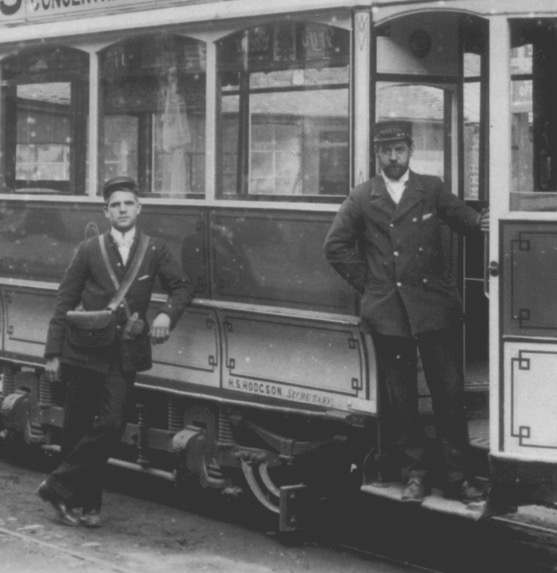
A conductor and a motorman pose for the cameraman with a pristine-condition Tramcar No 3 — photo undated, but probably taken in 1898 or 1899. The motorman (right) is wearing a double-breasted jacket, the conductor (left) a single-breasted jacket; although the latter jacket looks to have lapels, it actually has stand-up collars, the conductor evidently having unbuttoned the top two buttons of his jacket. Photo courtesy of the Tramways and Light Railway Society, with thanks to David Voice.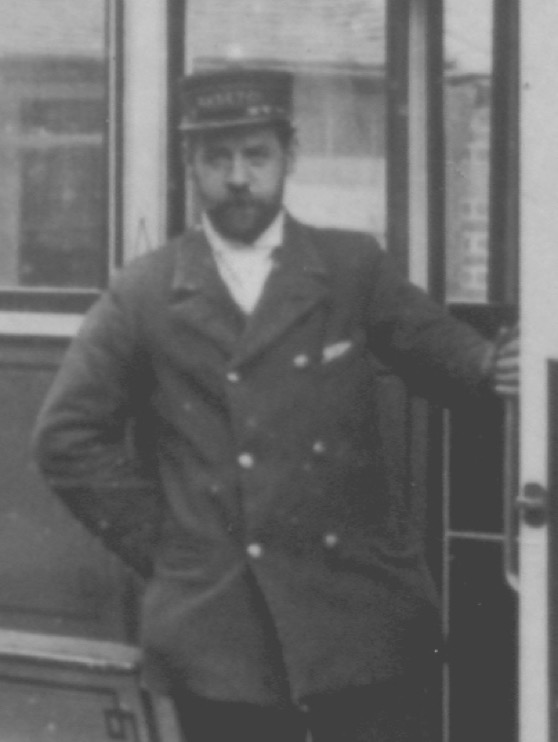
An enlargement of the above photograph showing the motorman. Whilst his cap appears to bear embroidered company initials, 'K & S E T Co', his jacket would appear to be without any insignia whatsoever.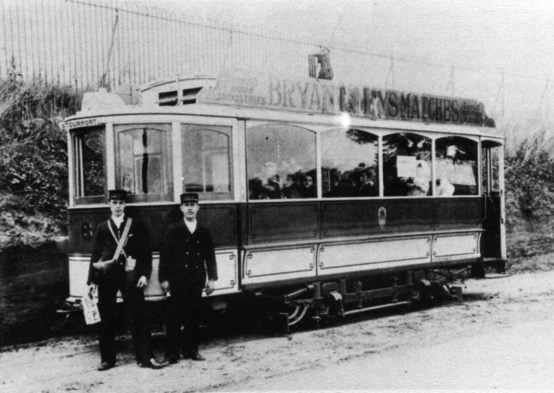
A conductor and a motorman pose in front of Tramcar No 6 between Oldington Farm and Upper Mitton — photo undated, but probably taken in 1899 given the tramcar's excellent condition. Photo courtesy of the Tramways and Light Railway Society, with thanks to David Voice.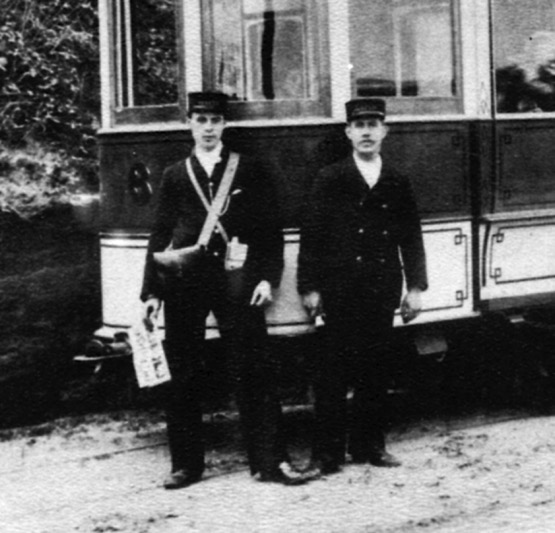
An enlargement of the above photograph showing details of the crew's uniforms. Both men's kepi-style caps clearly bear cap badges, the lack of reflections strongly suggesting that they were embroidered.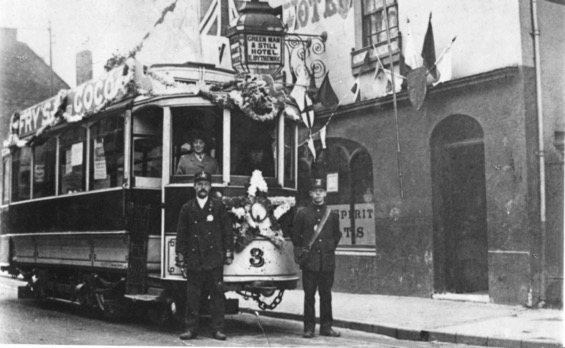
Tramcar No 3 again, this time outside the Green Man & Still Hotel in Kidderminster. The tramcar is decorated for the coronation of King Edward VII, so the photo was presumably taken in August 1902. Author's Collection.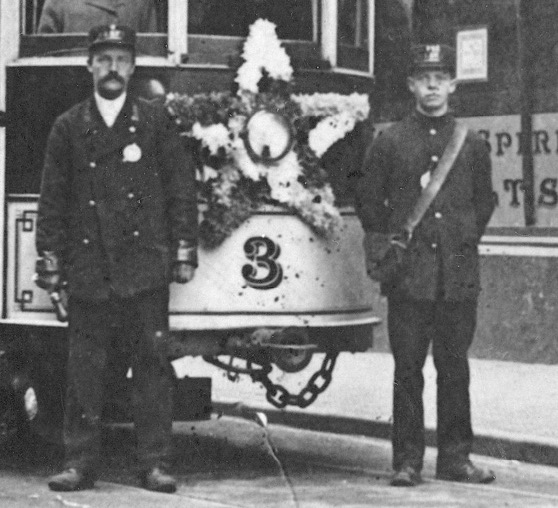
An enlargement of the above photograph showing the crew, the motorman once again in a double-breasted jacket, the conductor in a single-breasted jacket. Both men are wearing round licence badges, which were probably introduced around the turn of the century. The subjects' kepi-style caps clearly bear reflective cap badges, suggesting that a switch had been made to metal cap insignia by this time. Although far from certain, the badge would appear to comprise system initials, 'K&SET', and to be of one-piece construction rather than individual letters. There is also a hint of another badge above this, possibly either employee numbers, or the BETCo's 'Magnet & Wheel' cap badge.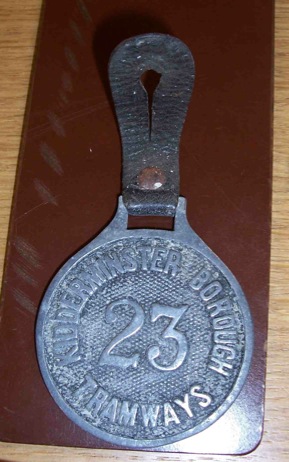
Kidderminster municipal tramways licence badge — alloy. This appears to have been issued from the turn of the century, but had been dispensed with by the time of the Great War. With thanks to the National Tramway Museum.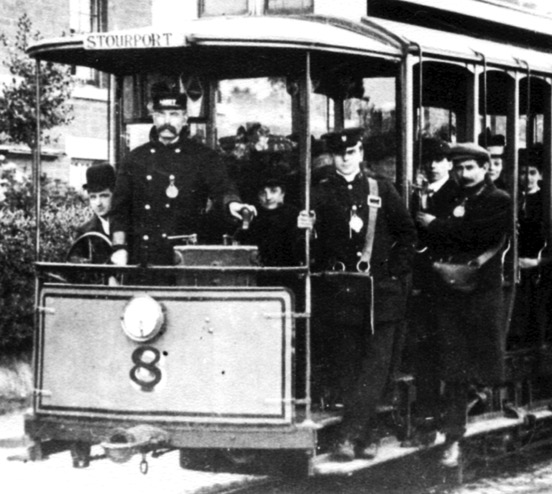
A motorman, a conductor and a temporary or relief conductor pose aboard Tramcar No 8 near Upper Mitton in the early 1900s. The motorman appears to be wearing a one-piece metal block-capitals cap badge on his kepi-style cap, wheres his conductor probably has a standard BETCo 'Magnet & Wheel' cap badge, but on a tensioned-crown peaked cap. The second conductor is wearing informal attire, though like his colleagues, his does have the municipal licence badge. Photo courtesy of the Tramways and Light Railway Society, with thanks to David Voice.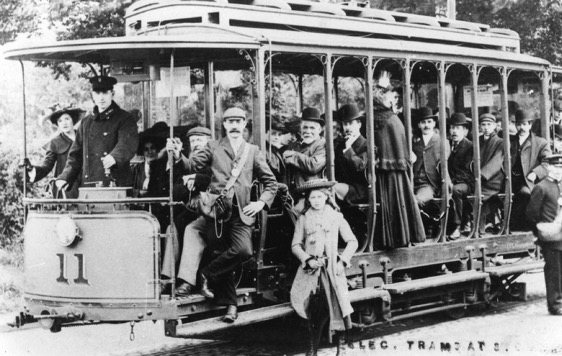
Motorman Francis Thompson and Temporary/Relief Conductor William Harris pose with a jam-packed Tramcar No 11 at Burlish Loop, Stourport, in 1905. Author's Collection.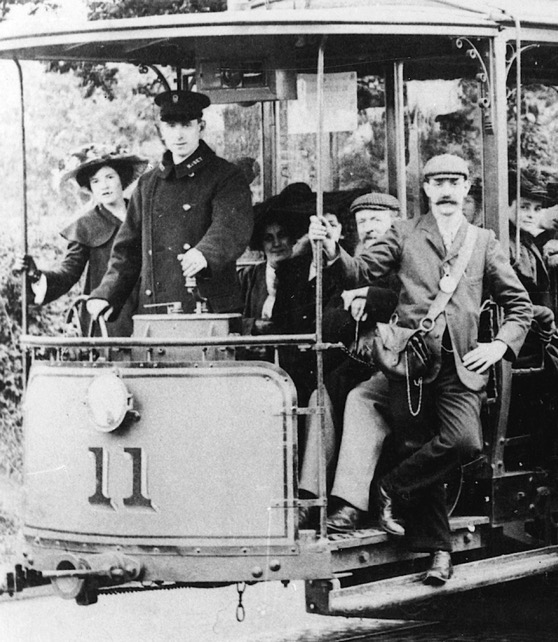
An enlargement of the above photograph. The relief conductor — a temporary role to deal with heavily loaded cars — is in informal attire, though he does have a municipal licence badge to prove his authority. The conductor proper (Alan Arley) is actually at the back of the tram, half in shot on the full photo.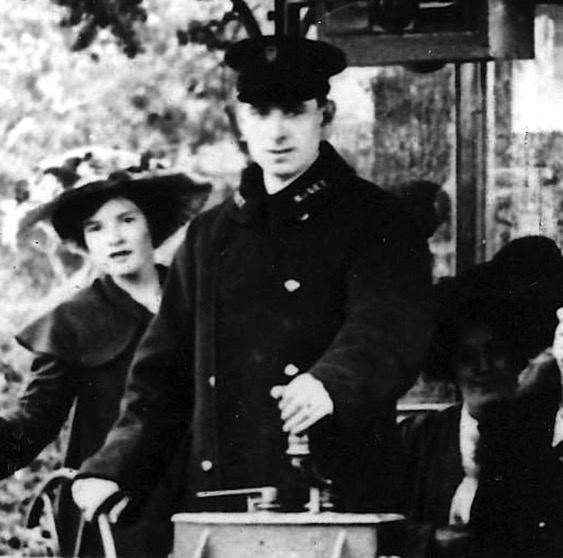
Another blow-up of the above photograph, this time showing details of Motorman Thompson's uniform, including the standard BETCo 'Magnet & Wheel' cap badge along with individual brass system initials, 'K & S E T' on his greatcoat collars.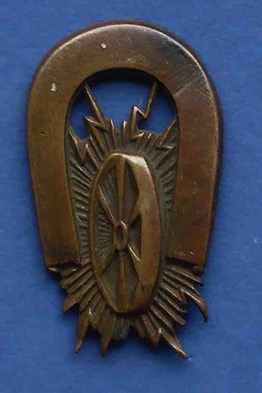
Standard British Electric Traction Company ‘Magnet & Wheel’ cap badge — brass. Author's Collection.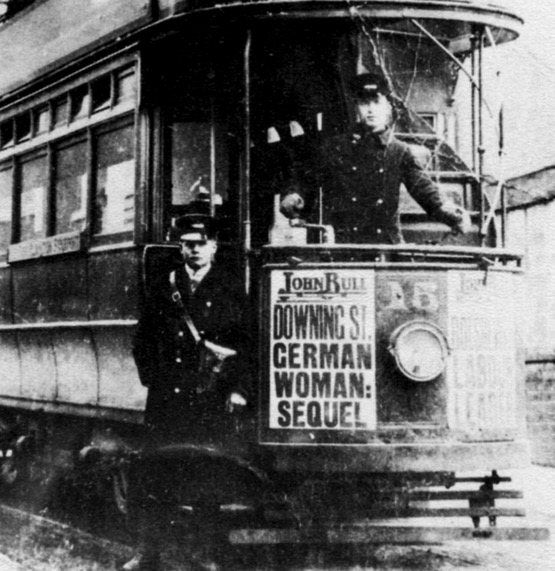
A rather poor quality Great War photograph of Tramcar No 15 and its crew at the terminus at Stourport. Although neither man appears to be wearing a BETCo 'Magnet & Wheel' cap badge, this is probably because they are in shadow, or alternatively, hidden behind rain covers. This and the next photograph, however, do suggest that an oblong badge (of unknown pattern) was worn beneath the main BETCo cap badge during and shortly after the Great War. Photo courtesy of the Tramways and Light Railway Society, with thanks to David Voice.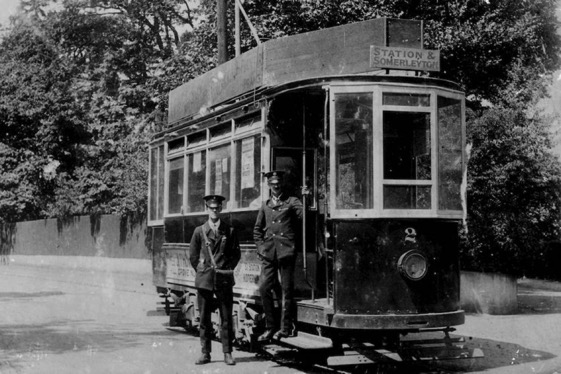
The crew of Tramcar No 2 pose for the camera at the Somerleyton Terminus, Kidderminster, around 1920. Photo courtesy of the National Tramway Museum. 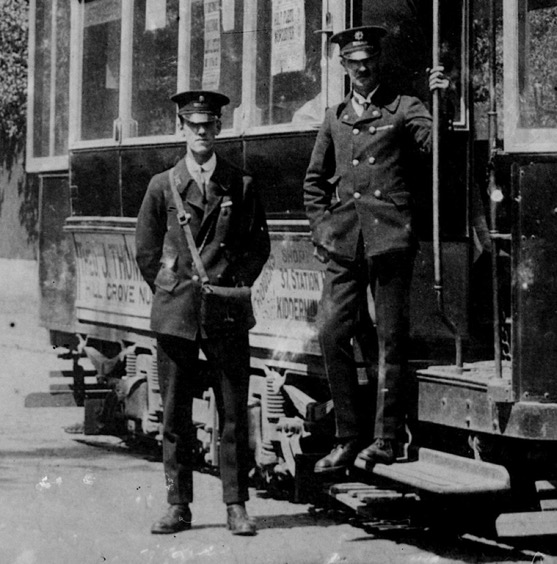
An enlargement of the above photograph showing the conductor and motorman. Both men appear to be wearing the standard double-breasted jacket (with high fold-over collars bearing brass 'B M T' initials) issued to all B&MTJC tramwaymen, but with the top buttons unbuttoned, giving a false impression of lapels. Whilst the conductor is wearing a BETCo 'Magnet and Wheel' cap badge, the motorman has a badge of unknown pattern, which is very probably military in origin; the wearing of regimental badges (presumably ex-unit) being quite commonplace during and after the Great War. Both men also appear to be wearing an oblong cap badge beneath their main BETCo cap badges. Photo courtesy of the National Tramway Museum. 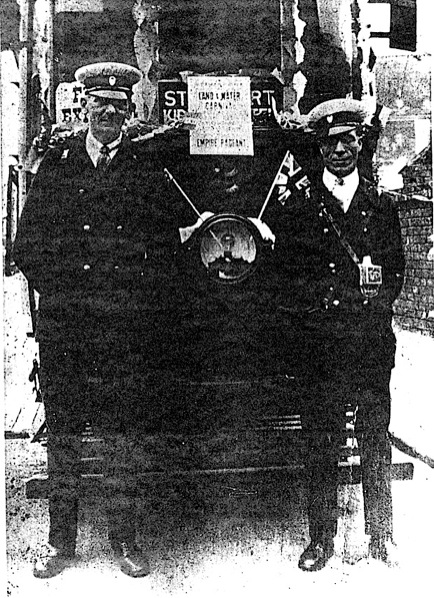
A very poor quality photograph, but one which does show that crewmen wore 'B M T' initials on their right-hand jacket collars, but with the standard BETCo 'Magnet & Wheel' cap badge rather than its BMTJC equivalent — photo undated, but probably taken in the early 1920s. Photo courtesy of the Tramways and Light Railway Society, with thanks to David Voice.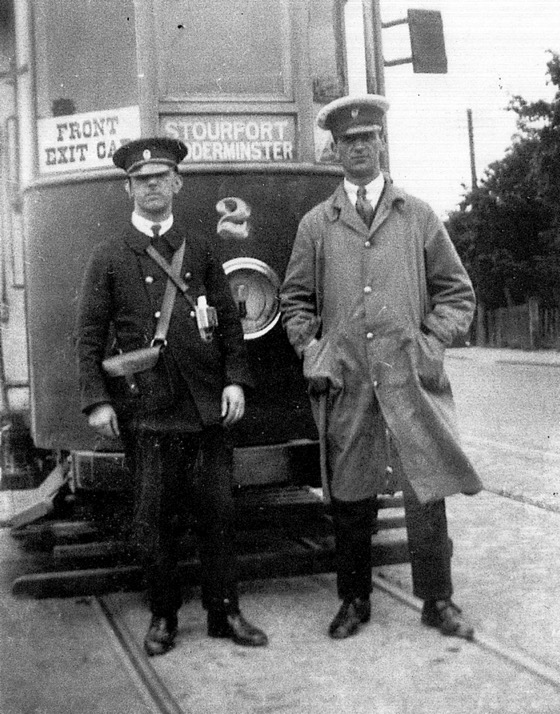
Tramcar No 2 once again — photo undated, but probably taken in the mid-to-late 1920s. The motorman is wearing a lightweight summer dustcoat of a type issued by many tramways during the 1920s and 1930s. The conductor is wearing a typical BMTJC double-breasted jacket with high, fold-over collars, but devoid of the usual insignia. Photo courtesy of the Tramways and Light Railway Society, with thanks to David Voice.
Senior staff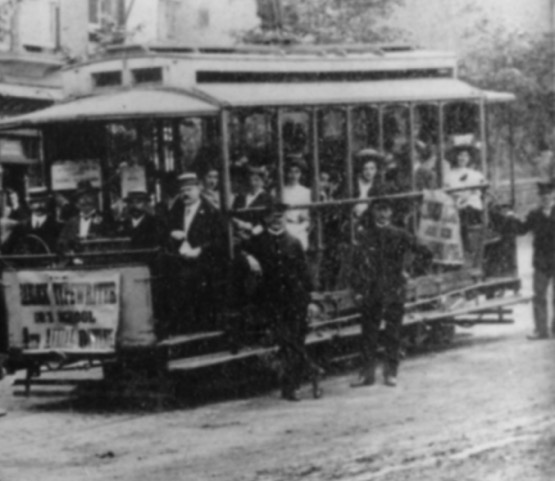
A poor quality photograph, but the only one I am aware of which shows an inspector (centre right) — photo undated, but probably mid-to-late Edwardian. The inspector is wearing a typical style of uniform used across the BETCo for senior staff (inspector and above).